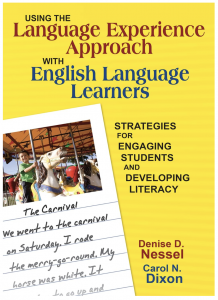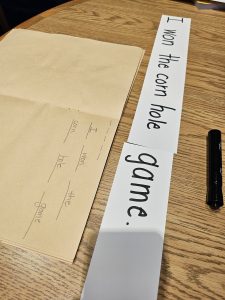Program adaptation for emergent speakers of English in the elementary grades has a lot of challenges. Educators have to adapt their classroom programming to make content comprehensible, set appropriate goals for language output, while also providing opportunities for the student to learn English.
This is where the Language Experience Approach, or LEA, comes in. LEA will not be a new strategy to many experienced teachers – it has been practiced for years in classrooms. It is a fantastic strategy for teaching literacy skills to English language learners (ELLs). Though you can find explanations all over the internet, Denise Nessel and Carol Dixon’s 2008 book “Using the Language Experience Approach with English Language Learners” remains a quintessential resource on the subject.
LEA combines experiential learning, oral communication, writing, and reading skills in fairly straightforward and textbook-free lessons. While many iterations of LEA exist, the central principle, as the Nessel and Dixon state, is to use the “student’s own vocabulary, language patterns, and background of experiences to create reading texts”.
At the core of LEA is building English vocabulary (or any target language you are teaching) through experiential learning. Through experiences, students naturally start connecting the words they hear with meaning. The experience can be something as simple as a classroom activity; as an educator, your role is to enrich that experience by explicitly teaching related words and their meaning.
For example, you might label items in the classroom, while also making a point of referencing those words during the day. When giving instructions to to students, explain the meaning of the action words as much as possible through movement and facial expression. The early learners of English in the classroom might receive flashcards with frequently used nouns, and be provided with opportunities to say those words in simple statements with common word patterns that have been modelled by the teacher.
There are a number of ways you can utilize LEA, but in this blog, I will focus on using LEA using sentence strips. This would be a great way to provide focused instruction to ELLs while other students are engaged in their own writing or drawing.
The Process
Start using LEA by taking students through an experience – it can be a day outdoors, an afternoon of playing games, or even exploring a picture or video if that is what you have done. The activity that follows is best used with ELLs that have acquired a basic oral foundation and can communicate using simple sentences (Ex. STEP 2).
When the experience is over, there are a number of different starting points you can work from. For early learners of English or primary students, you can start by having the class illustrate what they have experienced, whether it was playing a game or visiting a zoo. Students that are already writing sentences may choose to write about their drawing if they feel comfortable doing so.
While the class is drawing, start with one student and ask them to say a sentence about the experience or what they have drawn. Scribe the sentence exactly as the student says it. It’s important to use the student’s exact language so they will recognize their words when they reread their own writing, and they will also feel encouraged in creating dictated accounts.
If you want to gently encourage a revision, you might ask questions to help the student adapt their statement on their own. But you will want to make sure that the student has stated the words you scribe – avoid changing the text or they may not recognize the vocabulary or language pattern.
For example:
Teacher: What happened during the basketball game? Tell me one thing.
Student: I got a basket and scored a point.
Teacher: Oh, so you shot the ball in the basket and scored a point?
Student: Yeah, I shot the ball in the basket and scored a point.
Teacher: How should I write that down?
Student: I shot the ball in the basket and scored a point.
Teacher: (writes the sentence exactly as the student has said it).
Once you have scribed the student’s sentence in their notebook or journal, take a long strip of paper and write the sentence on that strip using a marker. Cut each word on the strip.

Then, ask the student to put the words back in the correct order using the sentence that has been scribed for them. Ask the student to read the sentence back to you. Repeat twice. Once the student has mastered the sentence, you can ask them to read the sentence to a friend or partner.
Then, you can move onto the next student! You might use sentence strips again, or provide more advanced feedback to students who are already independently writing.


